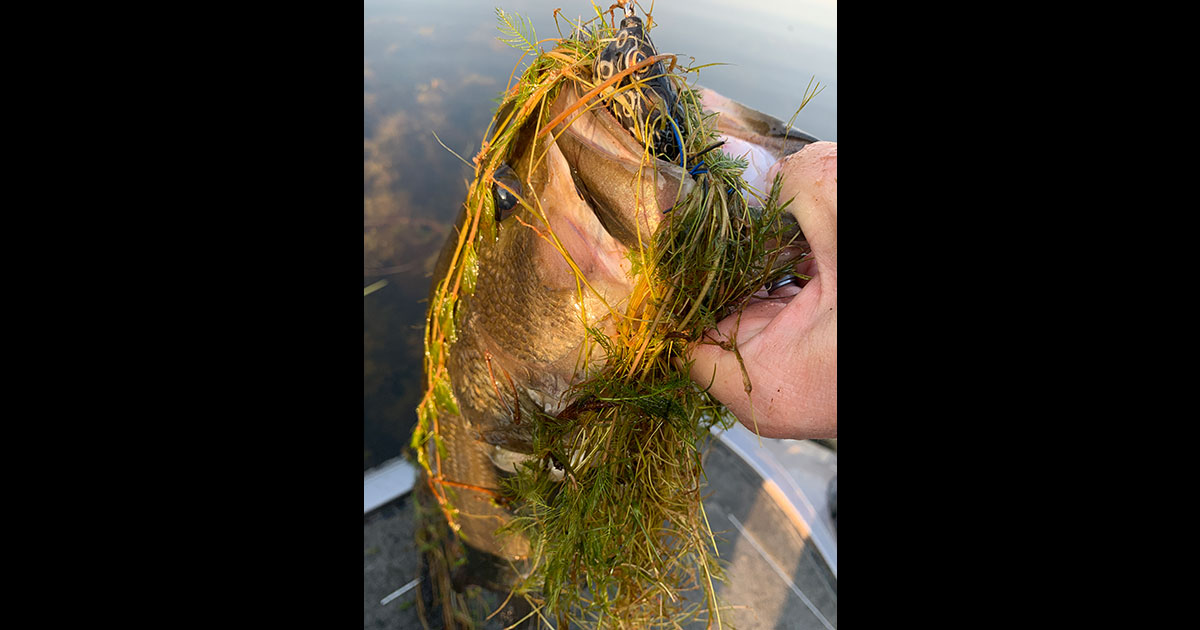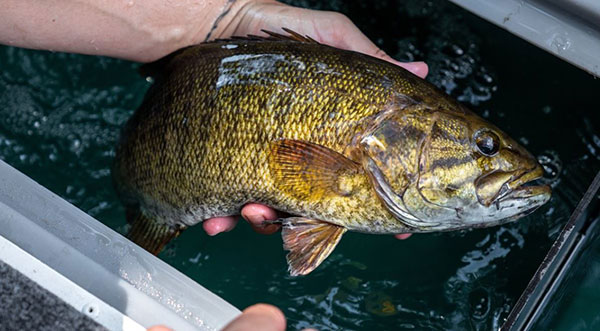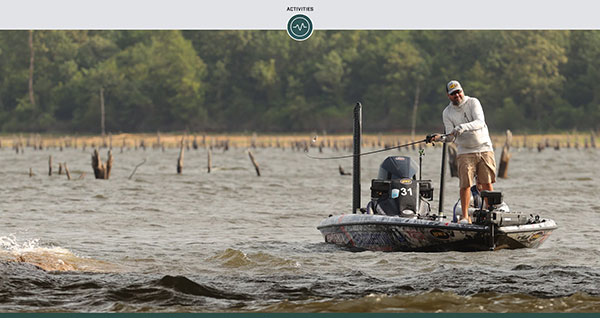- Details
Seaguar Report
 Largemouth bass
Largemouth bass
One of the surefire ways to get around bass is to fish around the grass. They love the stuff and there's always a percentage of the population living near the green stuff.
Many different lures work, but Seaguar pros and Bass Pro Tour anglers Gerald Spohrer and Mark Daniels, Jr. focus on efficiency. Both spent their fishing upbringings around grass, with Daniels learning bass fishing on the famed California Delta and Spohrer spending his time in the bayous of Louisiana, two regions known for expanses of aquatic vegetation.
Spohrer prefaced his talk on grass fishing with a simple outlook for baits, rods, and lines. "You need to have the right tool for the job and if it's not working, you need to try something that does the job better," he said. "Everything comes down to feel and you want to be able to fish effectively without getting stuck in the grass the whole time. You also want to make sure that you're never underpowered and can get the fish out of it."
To do this, Spohrer and Daniels each pick the right gear for the vegetation in front of them, varying it based on the vegetation type and thickness.
Punching Matted Vegetation
Sometimes, especially in the dead of summer, the grass is so thick that it's topped out and forms a mat. One of the only ways to fish efficiently in these situations is to crash right through the grass with the help of a heavy tungsten weight.
This is one of Daniels' favorite ways to fish and he'll punch a small crawfish imitating plastic paired with weights starting at ¾-ounce and up to over 2 ounces depending on the thickness of the grass. For line, he always begins with 50 lb Seaguar TactX, a 4-strand braided line with a rough textured finish to help cut through the grass.
"I start with 50 and always advocate that with punching because it's all about efficiency and how many times you can punch through the mat in a day," he said. "50 lb with a smaller diameter will penetrate the mats easier than 65 lb, but sometimes you have to use the heavier line if you use weights over 2 ounces and around huge fish. TactX is legit and tears right through the grass on the hookset and that makes a big difference in landing more fish."
Spohrer is also a big proponent of punching and uses a similar approach but differs in his line selection, opting for the 8-strand Seaguar Smackdown braid in a 65 lb test. "I love how smooth it is and how easily it comes off the reel," he said. "It's very quiet coming through the guides, and I like that. TactX is great, but a little louder, but it has its place for several techniques."
Frogs and Other Topwaters
Another great way to fish around thick grass is with a hollow body frog. It's fun and effective at fishing around matted grass, lily pads, and more.
Spohrer prefers to fish his frogs on 50 lb TactX. "I use it when throwing a frog around pads because it slices right through them when you make a strong hookset," he said. "Smackdown does cast a little bit better, in my opinion, but it doesn't cut through grass as easily as TactX does. It's my choice for more open areas or when fishing a frog around isolated cover like overhanging trees, docks, and scattered grass."
Daniels uses the same approach and starts with 50 lb TactX instead of the 65 lb that some prefer. "Your castability is going to be much better because of the smaller diameter," he said. "I know if I hook one and it buries me in the grass, it's not going anywhere, and I can get him out."
Both anglers will also mix in other topwaters such as buzzbaits, plopping baits, and prop baits and target holes in the grass and right along the grass lines.
Daniels fishes these baits on braided line, 40 lb Smackdown, and will add a short 8 to 12-inch leader of 20 lb Seaguar AbrazX fluorocarbon for the prop bait and plopper.
"I like the Smackdown for these topwaters because it casts so well," he said. "The fluorocarbon leader is necessary for baits with treble hooks and props because the limp braid tends to wrap up on them when you work the bait. That short leader of fluorocarbon is stiff enough to keep it in front of the bait and will eliminate a lot of those issues."
- Details
Mercury Report
 Smallmouth bass
Smallmouth bass
Catch and release is one of the best aspects of bass fishing. The entire culture is built around this principle, with recreational and tournament anglers alike tossing back most of the bass they catch.
For the concept to work, it goes without saying that the fish must live. We owe it to the resource to ensure that the fish we handle, photograph and weigh in fight again to thrill another angler in the days ahead.
The first step in this principle is learning how to care for bass being held in a livewell. It’s not as easy as just filling the tank with water and dumping in keepers. Let’s dive in, so to speak.
Your livewell fills with lake water – the same water harboring your bass – but from the perspective of the fish, the similarity ends there. The instant fish are held in captivity both their biological makeup and the water itself change.
When held in a livewell, bass secrete an extraordinary amount of waste product into the water, mainly in the form of ammonia and carbon dioxide. This is due to a combination of respiration (breathing) and stress. As this waste enters the water in the livewell, the water begins to change, slowly becoming toxic to the fish held within.
- Details
Mercury Report
 Greg Hackney
Greg Hackney
Greg Hackney is an independent thinker. Over two decades of professional fishing, the Mercury Pro Team member has learned to trust his gut over going with the flow — unless he’s dealing with actual flowing water.
In that case, Hackney knows that current remains one of the most predictable powers influencing where, when and how bass position. The Bassmaster Elite Series veteran recently shared his thoughts on strategies for finding and catching current-oriented bass.
1. Consider Seasonal Patterns
Current-related patterns vary by season. During most of the year, bass take advantage of the flowing water to forage, as the current helps deliver food. In spring, this holds true in the prespawn and postpsawn periods. However, in between, Hackney expects to find bass moving away from the heaviest current to spawn. Where this occurs depends on the fishery.
“With river fish that live in current, there’s no migration. They may live out on main river bars, and they literally just go to the bank to spawn,” he said. “Whereas, in southern Louisiana, the fish will run away from the current and spawn in the backs of canals where the water is warmer.”
While spring rains and snowmelt often bring heavy flows, the summer months typically see less water volume moving through river systems.





